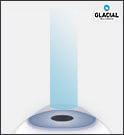
If you’re not an ideal candidate for LASIK eye surgery, PRK could be an option that you may want to consider. PRK can correct nearsightedness, farsightedness and astigmatism.
If you have been doing some LASIK research you may come across a term called PRK. PRK is a form of laser vision correction that was actually FDA approved before LASIK eye surgery and may have potential benefits for you. PRK was the first laser refractive surgery approved by the FDA receiving final approval in 1995. PRK is a refractive eye surgery procedure that utilizes the excimer laser to reshape the cornea and improve nearsightedness, farsightedness, and astigmatism much like LASIK eye surgery. Once the cornea has flattened, light rays are more easily focused upon the retina. PRK differs from LASIK in that no flap of tissue is created prior to resculpting the cornea with the excimer laser. In LASIK this flap creation does enable a faster recovery period.
PRK (Photo-Refractive Keratotomy) Procedure
The procedure can be performed once the eye has been numbed with anesthetic drops. A speculum will be positioned to hold your eyelids back just like in LASIK so that you eyelids will not interrupt the actual surgery. The ophthalmologist will then remove the outer cornea cells and proceed with the actual laser treatment. The laser is then positioned to directly treat the cornea. This laser delivery takes less than one minute to complete for most patients. Once the laser treatment or refractive ablation is completed, the corneal curvature is reshaped, thus improving the refractive error. Your ophthalmologist will then place a bandage contact lens on the eye for improved comfort along with anti-inflammatory and antibiotic eye drops.
Post-operatively, our patients will be re-evaluated one day, three days, one week, one month, two to three months, and four to six months following the PRK procedure. The bandage contact lens can usually be removed on the second or third post-operative day when the epithelium is healed. Most patients will only require eye drops to control healing during the first 6 to 12 weeks, but other patients may require topically applied medications for up to 6 months or more following the procedure. In general, the greater the refractive error, the more likely the patient is to require eye drop medications for a prolonged period following the procedure.

